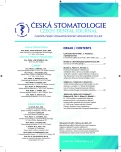The Incidence of Agenesis of Third Molars in Children in the Olomouc Region
Authors:
L. Kramerová 1; P. Krejčí 1; E. Kaplová 1; K. Langová 2
Authors‘ workplace:
Klinika zubního lékařství LF UP a FN, Olomouc
1; Ústav lékařské biofyziky LF UP, Olomouc
2
Published in:
Česká stomatologie / Praktické zubní lékařství, ročník 114, 2014, 3, s. 35-42
Category:
Casual study
Overview
Aim of the study:
Third molars have a special position in dentition. The reasons of this are extreme deviations in the developmental process, together with frequent agenesis of third molar. Their absence is considered normal very often. This paper aims to investigate the epidemiology of agenesis of third molars in children in the Olomouc Region, to compare its frequency in boys and girls, to determine the prevalence of agenesis of third molars of different localization, to compare its frequency in upper and lower jaw and in right and left side and to make comparisons with Rozkovcová et al. study.
Material and methods:
The study was conducted from 1. 10. 2010 to 1. 2. 2013 at the Pediatric department of Institute of Dentistry and Oral Sciences of Faculty of Medicine and Dentistry of Palacký University Olomouc. It included boys and girls aged between 12 and 19 years. Clinical and radiographical evaluations were carried out. Age, gender, systemic diseases, syndromes, number and localization of missing third molars were recorded.
Results:
We worked with two groups of probands. The first consisted of 218 children aged between 12 and 19 years, the second consisted of 175 probands aged between 13 and 19 years. In the first, agenesis of third molars was found in 62 patients, the prevalence was set at 28.44%. In the second, agenesis of third molars was found in 52 patients, the prevalence was set at 29.71%. The difference between the values was not statistically significant. The majority of patient didn´t have only one or two third molars. Most often missed upper left third molar. In our group of patients, who had agenesis of one to four third molars, we found a significantly higher prevalence of agenesis of other teeth, than in patients with established all four third molars.
Conclusion:
The two-year study showed the prevalence of agenesis of third molars in boys and girls in Olomouc region at present. The results were compared with epidemiological investigations published by Rozkovcová et al. Most of the results were not significantly different.
Key words:
hypodontia – agenesis of third molars – incidence of agenesis of third molars
Sources
1. Bailit, H. L.: Dental variation among populations. An anthropologic view. Dent.Clin. North Amer., roč. 19, 1975, č. 1, s. 125–139.
2. De Coster, P. J., Marks, L. A., Martens, L. C., Huysseune, A.: Dental agenesis: genetic and clinical perspectives. J. Oral Pathol. Med., roč. 38, 2009, s. 1–17.
3. Garn, S. M., Lewis, A. B.: The gradient and the pattern of crown-size reduction in simple hypodontia. Angle Orthodont., roč. 40, 1970, č. 1, s. 51–58.
4. Hübenthal, B.: Beitrag zum Zusammenhang zwischen den Anomalien der Zahnzahl und der Weisheitszahnanlage. Med. Diss., Halle-Wittenberg, 1989.
5. Kavitha, B., Priyadharshini, V., Sivapathasundharam, B., Saraswathi, T. R.: Role of genes in oro-dental diseases. Indian J. Dent. Res., roč. 21, 2010, s. 270–274.
6. Keene, H. J.: The relationship between third molar agenesis and the morphologic variability of the molar teeth. Angle Orthodont, roč. 35, 1965, č. 4, s. 289–298.
7. Krejčí, P.: Hypodoncie. Souborný referát. Ortodoncie, roč. 15, 2006, č. 3, p. 21–29.
8. Krejčí, P., Fleischmannová, J., Matalová, E., Míšek, I.: Molekulární podstata hypodoncie. Ortodoncie, roč. 16, 2007, č. 1, s. 33–39.
9. Mostowska, A., Kobielak, A., Trzeciak, W. H.: Molecular basis of non-syndromic tooth agenesis: mutations of MSX1 and PAX9 reflect their role in patterning human dentition. Eur. J. Oral Sciences, roč. 111, 2003, s. 365–370.
10. Parkin, N., Elcock, C., Smith, R. N., Griffin, R. C., Brook, A. H.: The aetiology of hypodontia: The prevalence, severity and location of hypodontia within families. Arch. Oral Biol., roč. 54, 2009, č. 1, s. 52–56.
11. Rozkovcová, E., Dostálová, T., Marková, M., Broukal, Z.: The third molar as an age marker in adolescents: new approach to age evaluation. J. For. Sci., roč. 57, 2012, č. 5, s. 1323–1328.
12. Rozkovcová, E., Marková, M., Lánik, J., Zvárová, J.: Agenesis of third molars in young Czech population. Prague Med Rep., roč. 105, 2004, č. 1, s. 35–52.
13. Rozkovcová, E., Marková, M., Lánik, J., Zvárová, J.: Development of third molar in the Czech population. Prague Med Rep., roč. 105, 2004, č. 4, s. 391–422.
14. Rozkovcová, E., Marková, M., Mrklas, L.: Nové přístupy k problematice třetího moláru. Čes. Stomat., roč. 105, 2005, č. 5, s. 119–128.
15. Sottner, L., a kol. Genetika pro studující stomatologie, 1. vyd., Praha, 1981.
16. Tan, S. P. K., van Wijk, A. J., Prahl-Andersen, B.: Severe hypodontia: identifying patterns of human tooth genesis. Eur. J. Orthod., roč. 33, 2011, č. 2, s. 150–154.
17. Vastardis, H.: The geneticsof human tooth agenesis: new discoveries for understanding dental anomalies. Amer. J. Orthodont. dentofacial Orthop., roč. 117, 2000, č. 6, s. 650–656.
Labels
Maxillofacial surgery Orthodontics Dental medicineArticle was published in
Czech Dental Journal

2014 Issue 3
- What Effect Can Be Expected from Limosilactobacillus reuteri in Mucositis and Peri-Implantitis?
- The Importance of Limosilactobacillus reuteri in Administration to Diabetics with Gingivitis
Most read in this issue
- Use of Factory-Prepared Equimolar Mixture Nitrous Oxide/Oxygen in Paediatric Dentistry
- Comparison of Mono-Layer and Two-Layers Phantom Teeth Used in Preclinical Courses
- The Assessment of the Biocompatibility of Dental Alloys and Alloys for Dental Amalgam. Part First
- Er: YAG Laser Contact and Non-Contact Delivery Systems Cavity Preparation and Sonic-Activated Bulk Composite Restoration
